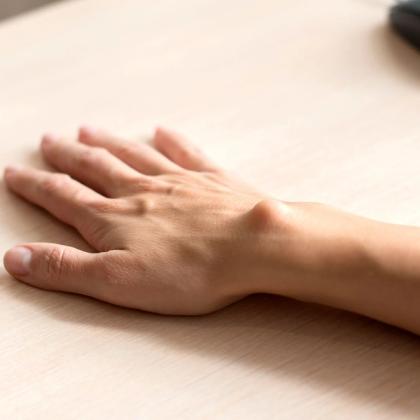This podcast episode is worth 0.23 CPD credits. Upgrade to Pro
Ganglion cysts, also sometimes referred to as synovial cysts, are the most common benign soft-tissue masses of the hand and wrist. These cysts arise from the synovial lining of joints or tendon sheaths and are filled with a gelatinous, mucin-rich fluid. Despite their benign nature, ganglion cysts can cause discomfort, restrict motion and cause neurovascular compression (requiring medical intervention in some cases). In this episode, Dr Roger Henderson looks at epidemiology, pathophysiology, clinical presentation, diagnostic modalities, differential diagnoses and treatment options.
Key take-home points
- Ganglions are the most common type of tumour located within the hand and wrist, accounting for approximately 50–70% of soft-tissue tumours found there.
- They are more likely to be present in women and have a female-to-male ratio of 3:1.
- Their peak incidence occurs between the ages of 20 and 40 years, with a much lower incidence in children and the elderly.
- These cysts most frequently occur on the dorsal aspect of the wrist (60–70%), followed by the volar wrist (15–20%), and less commonly in the flexor tendon sheath, foot, knee and shoulder.
- Although a definitive link between the development of a ganglion cyst development and traumatic injury has not been established, traumatic events may be recalled and linked to the ganglion in up to 40% of patients.
- Ganglion cysts are often asymptomatic but can present with swelling, pain and discomfort, decreased range of motion and neurological symptoms.
- The transillumination test is a hallmark of ganglion cysts and is positive when light shone from a penlight passes through the cyst, differentiating it from solid tumours.
- Laboratory tests are usually entirely normal and are only required if there are suspicions that infection may be present. Imaging is usually not indicated unless the cause of the mass is doubted.
- Dorsal ganglia may be aspirated for diagnostic (as well as potentially curative) purposes but aspiration of any volar ganglia is not recommended due to the potential risk of injury to the radial artery.
- A clear, jelly-like, viscous mucin is diagnostic of a ganglion cyst.
- Conservative treatment results in spontaneous resolution in over half of adults and nine out of 10 children over a 9- to 12-month period.
- Cyst puncture and drainage, with or without corticosteroid injection, is the primary form of closed management of dorsal ganglia.
- Almost six out of every 10 patients who undergo aspiration experience recurrence at some time.
- Indications for surgical excision include pain refractory to conservative treatment, neurovascular compromise, functional impairment and recurrence following aspiration.
- Attempting to cure a ganglion using blunt trauma is not to be recommended and may lead to problems such as fracturing of the distal radius or injury to the surrounding structures.
Key references
- Gregush RE, Habusta SF. StatPearls [Internet]. 2023. https://www.ncbi.nlm.nih.gov/books/NBK470168/.
- Wong AS, et al. Hand (N Y). 2007;2(3):117-119. doi: 10.1007/s11552-007-9032-8.
- Suen M, et al. ISRN Orthop. 2013;2013: 940615. doi: 10.1155/2013/94061.
- Dias JJ, et al. J Hand Surg Eur Vol. 2007;32(5):502-508. doi: 10.1016/J.JHSE.2007.05.007.
- Bontempo NA, Weiss A-PC. Hand Clin. 2014;30(1):71-75. doi: 10.1016/j.hcl.2013.08.020.
- Kuliński S, et al. Adv Clin Exp Med. 2019;28(1):95-102. doi: 10.17219/acem/81202.
Create an account to add page annotations
Annotations allow you to add information to this page that would be handy to have on hand during a consultation. E.g. a website or number. This information will always show when you visit this page.
